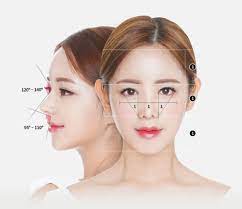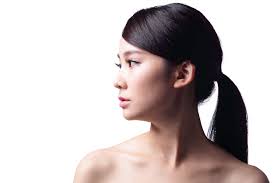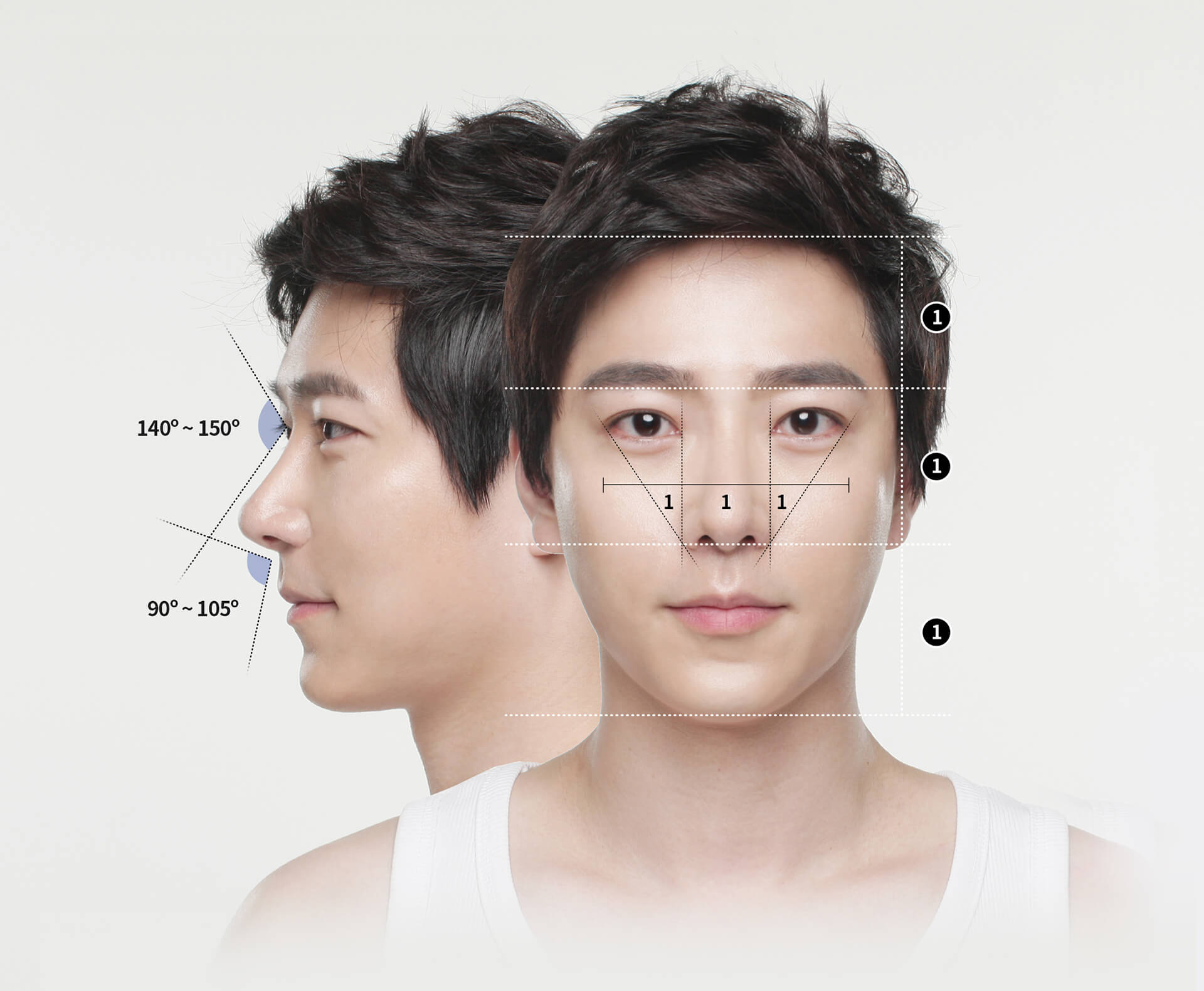Hello!
Nose shape holds a lot of significance in the Asian community-given that most Asians have thinner noses and more pronounced features. However, while having an Asian nose is considered aesthetically pleasing, having a large nose can be problematic given the number of negative judgments and feelings it evokes. Some people might feel disdain for the way others perceive them, or others might even feel hatred towards them solely based on their nose size.
1. The Low Bridge (Dorsum)
 The first feature that needs to be addressed within the Asian nose is the low-bridge (there are many other things to consider, such as the dorso-tip, bridge-width, etc.), which is caused because the nasal bones are shorter than those of a Caucasian.
The first feature that needs to be addressed within the Asian nose is the low-bridge (there are many other things to consider, such as the dorso-tip, bridge-width, etc.), which is caused because the nasal bones are shorter than those of a Caucasian.
To address this feature, a patient can undergo a dorsal augmentation surgery, which raises the bridge of their nose through surgical reconstruction. Asian rhinoplasty is also a viable option. It is important to note that even if the patient undergoes both procedures, the nose will be slightly raised instead of Caucasian noses, typically much higher than Asian noses. This surgery can effectively correct this feature and help patients feel more confident in their physical appearance.
2. Dorsal View (Sagittal) Vs. Ventral View (Horizontal)
 The second feature that needs to be addressed within the Asian nose is the dorsal view vs. the ventral view, which is the main difference between an Asian nose and a Caucasian nose. In general, Asians have thinner noses than Caucasians due to their smaller nasal bones and shorter bridge, making a larger dorsal view more prominent than a ventral view. Therefore, patients need to consider their dorsal and ventral views when undergoing rhinoplasty procedures. The tip should be wide enough to balance out the typically smaller bridge than Caucasians in the posterior view. This can be achieved by widening the tip through an open procedure like Asian rhinoplasty. Also, the nostrils need to have an adequate amount of flare and should not be creased.
The second feature that needs to be addressed within the Asian nose is the dorsal view vs. the ventral view, which is the main difference between an Asian nose and a Caucasian nose. In general, Asians have thinner noses than Caucasians due to their smaller nasal bones and shorter bridge, making a larger dorsal view more prominent than a ventral view. Therefore, patients need to consider their dorsal and ventral views when undergoing rhinoplasty procedures. The tip should be wide enough to balance out the typically smaller bridge than Caucasians in the posterior view. This can be achieved by widening the tip through an open procedure like Asian rhinoplasty. Also, the nostrils need to have an adequate amount of flare and should not be creased.
3. The Tip (Sternum)
The tip of the nose is also essential to Asian noses as it should not be too small or too big based on its size. The tip needs to be narrow enough to balance out the bridge and wide enough to balance out the lower portion of the nose. The nostrils should not be creased and should have an adequate amount of flare. At this point, you might be wondering what causes a larger dorsal view or a larger tip among Asians. There are two possible explanations for that. First, patients might have too much soft tissue within their nose and require the tip to be wider. Second, a larger dorsal view can be caused by individuals who have an extensive nose.
4. The Bulbous TIP
 A bulbous tip is typically characterized by a tip that falls straight down and does not flare out.
A bulbous tip is typically characterized by a tip that falls straight down and does not flare out.
This feature is commonly seen in patients with a large nose and can make the nose appear more prominent than desired.
A hard-soft graft of Gore-Tex or AlloDerm can be performed to give the tip flare and reduce its appearance. A full rhinoplasty can also be performed to address the bulbous tip and other issues.
5. The Under Projected TIP
An under-projected tip is also common among Asian individuals with a large nose. In this case, the tip falls under the bridge and is typically close to the nostrils. The only way to correct this problem is to reconstruct the tip and nasal bone. The tip will appear more natural as it will not be under the bridge and therefore appear smaller than usual. This can be corrected through rhinoplasty by changing the angle of the projection towards the nostrils.
6. The Nasal Bone
A long nose is usually characterized by a large nose with a large nasal bone and a short bridge. In some cases, the nasal bone can be so long that they grow straight into either the lumpy forehead or even into the scalp. This can be corrected through various procedures such as a septoplasty, reduction of the nasal hump, and even surgical revisions.
7. The Tip Flare
 The tip flare is another feature that holds cultural significance within the Asian community. The larger the tip flare, the more feminine and pretty a woman appears based on their culture. Also, the smaller the tip flare is, the more masculine a man appears and the more outstanding of a man he is. Rhinoplasty surgery to address this feature will give the needed tip flare and will help balance out their Asian nose.
The tip flare is another feature that holds cultural significance within the Asian community. The larger the tip flare, the more feminine and pretty a woman appears based on their culture. Also, the smaller the tip flare is, the more masculine a man appears and the more outstanding of a man he is. Rhinoplasty surgery to address this feature will give the needed tip flare and will help balance out their Asian nose.
8. The Flaring Nose
A flaring nose is most visible from the side view and can also be seen in individuals with a large nose. In this case, the bridge becomes wider at the base, which gives the patient an unnatural look. This feature can be corrected through rhinoplasty by narrowing the base. It is also advantageous to reshape the tip and the nasal bone, allowing for a more natural look.
9. The Protruding Nose
A protruding nose is typically applied to individuals with a large nose. It can be observed in both children and adults, and it usually has two forms: small-protrusion and large-protrusion. The feature is usually noticed because the tip is too far from the center of the face; as a result, it projects outwards. This feature can be corrected through rhinoplasty by either reducing or reconstructing the nasal bones.
10. The Short Nose
 A short nose is usually characterized by a nose that is not long enough to balance out the bridge. Another feature that can be added to this category includes a flat nasal bridge, which can be found in some Asian individuals. This feature can be corrected through rhinoplasty by either lengthening the bones or reducing their width. This will, in turn, make the nose appear more natural and therefore more beautiful.
A short nose is usually characterized by a nose that is not long enough to balance out the bridge. Another feature that can be added to this category includes a flat nasal bridge, which can be found in some Asian individuals. This feature can be corrected through rhinoplasty by either lengthening the bones or reducing their width. This will, in turn, make the nose appear more natural and therefore more beautiful.
11. The Knocked Nose
A knock-nose is typically characterized by the end of the nose that faces forward being slanted. This feature is commonly seen in children, but it can also be present in adults. There are two types of knock-noses: age-related and trauma-related. A tip can also be reconstructed to correct this feature. Also, the nasal bones and cartilage can be reduced to remove a knock-nose.
Also read:
- 5 Tips for Creating Topic Clusters and Pillar Pages to Boost Your Rankings
- Digital Marketing Trends Your Small Business Should Always On
- From Playdates to Parent-Teacher Meetings: Dressing Well as a Single Dad
Conclusion
 You need to understand the anatomy of the Asian nose so that you can get an idea of what to expect when undergoing rhinoplasty. You must consider your dorsal, ventral, posterior views, and several other factors. Once your rhinoplasty surgery has been finalized, you will have a beautiful Asian nose that looks natural and can complement your frame.
You need to understand the anatomy of the Asian nose so that you can get an idea of what to expect when undergoing rhinoplasty. You must consider your dorsal, ventral, posterior views, and several other factors. Once your rhinoplasty surgery has been finalized, you will have a beautiful Asian nose that looks natural and can complement your frame.
Thank you!
Join us on social media!
See you!






